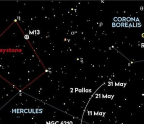CUTTING EDGE

Exoplanets dancing around double stars
What weird and wonderful orbits might be possible around binary stars?
Although the vast majority of extrasolar planets discovered so far are around singleton suns, many of the stars in our Galaxy are part of binary or multiple systems. It’s much trickier to detect exoplanets in multiple systems (for example, the other bound stars completely swamp any sign of a companion planet), but there’s no reason to suppose that they’re not also pretty common.
There are three different kinds of orbit that a planet in a binary star system can remain stable within. The first is a ‘satellite-type’ or S-type internal orbit, whereby the planet circles one of the two stars. Astronomers have discovered around 50 confirmed exoplanets on S-type orbits, and
You’re reading a preview, subscribe to read more.
Start your free 30 days





